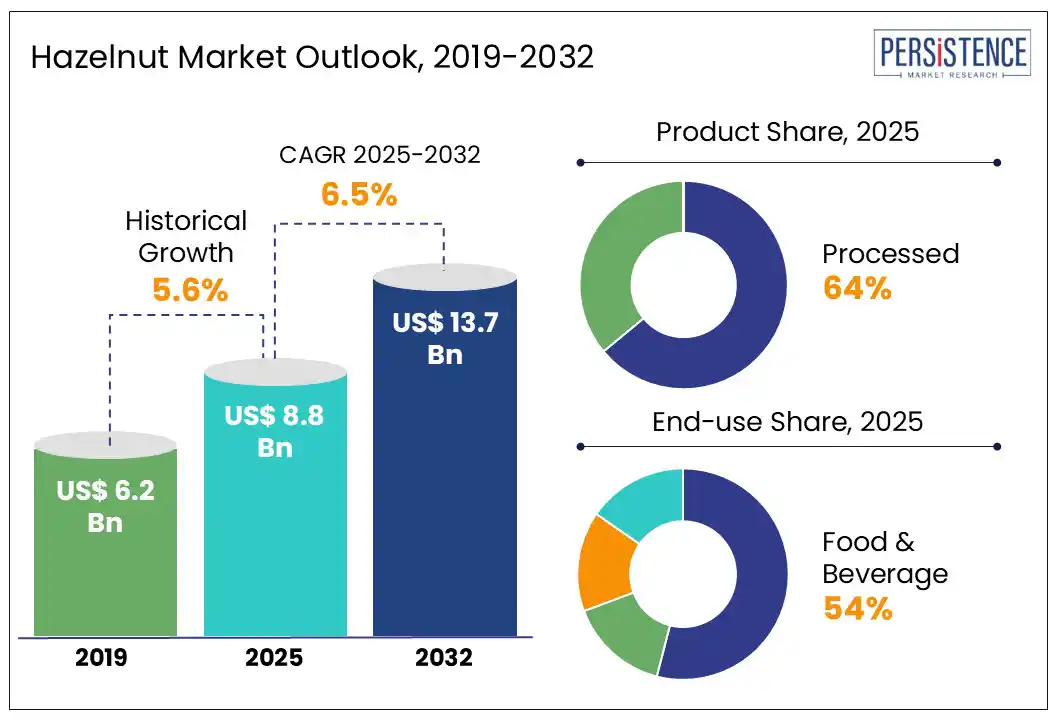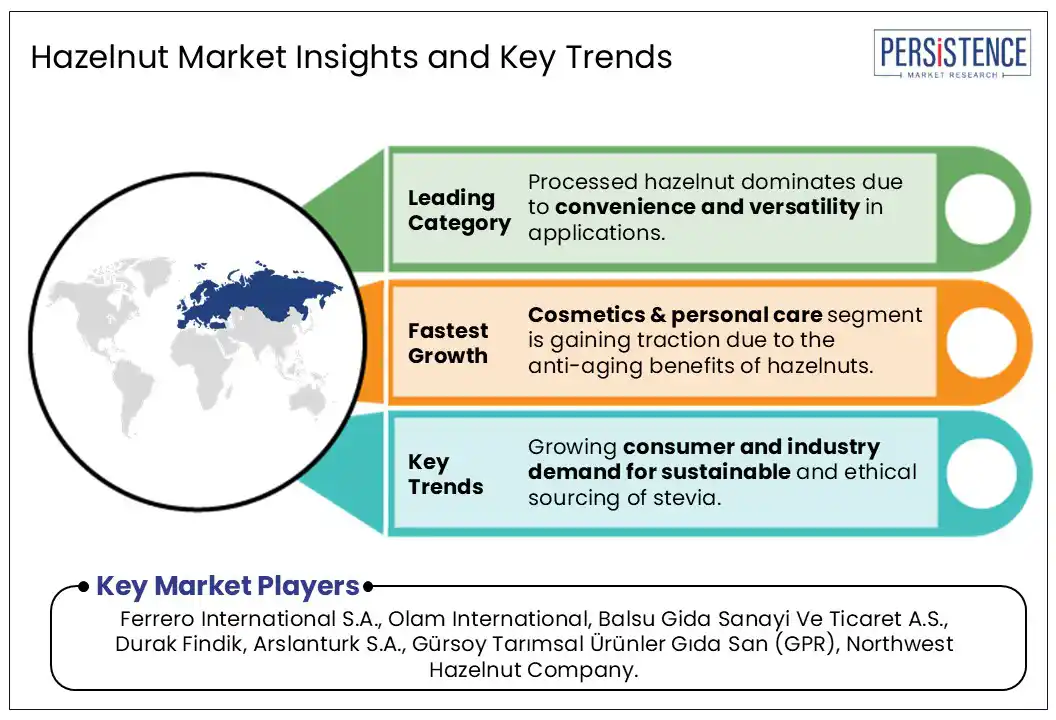ID: PMRREP14005| 181 Pages | 30 Jul 2025 | Format: PDF, Excel, PPT* | Food and Beverages

The global hazelnut market size is likely to be valued at US$ 8.8 Bn in 2025 and is estimated to reach US$ 13.7 Bn in 2032, growing at a CAGR of 6.5% during the forecast period 2025 - 2032. The hazelnut market growth is driven by rising adoption in plant-based dairy, skincare, and specialty health foods, fueled by clean-label demand, sustainable sourcing, and limited regional cultivation capacity. Cold-pressed hazelnut oil is in high demand in both the food & beverages and cosmetics & personal care industries. Modern processing methods ensure the retention of key nutrients that can be degraded by excessive heat. This high demand is owing to the rising consumer preference for organic and clean-label products.
The cosmetics and personal care industry is estimated to progressively adopt hazelnut-based oils for their antioxidant, moisturizing, and anti-aging properties. Hazelnut oil was reportedly included in 15% of anti-aging skincare products launched globally in 2023. Hazelnut milk is gaining traction as a plant-based option owing to its creamy and nutty flavor. It is a common ingredient in plant-based spreads, dairy-free chocolates, and protein bars, catering to the rising demand for vegan and gluten-free options.

Key Industry Highlights:
|
Global Market Attribute |
Key Insight |
|
Hazelnut Market Size (2025E) |
US$ 8.8 Bn |
|
Market Value Forecast (2032F) |
US$ 13.7 Bn |
|
Projected Growth (CAGR 2025 to 2032) |
6.5% |
|
Historical Market Growth (CAGR 2019 to 2024) |
5.6% |
Rising demand from the chocolate and confectionery industry is a major driver of growth in the hazelnut market. Hazelnuts are a preferred ingredient for premium chocolate products due to their rich, nutty flavor, smooth texture, and strong consumer association with indulgence and quality. In Europe, especially in countries including Italy, Germany, and Switzerland, hazelnuts are widely used in pralines, spreads, and nougats, forming an essential component of regional chocolate formulations.
The U.S. chocolate industry is also witnessing a growing preference for hazelnut-infused products, with brands innovating around nut-based inclusions in artisanal and functional chocolates. A notable example is Ferrero, the maker of Nutella and Ferrero Rocher, which alone accounts for a substantial portion of global hazelnut consumption. Their sustained expansion in both the U.S. and Europe highlights how the chocolate sector’s innovation and scale are anchoring hazelnut demand across global supply chains.
Approximately 90% of the global hazelnut supply is sourced from just five countries, Türkiye, Italy, the U.S., Georgia, and Azerbaijan, making the market extremely sensitive to regional disruptions. Hazelnuts require specific agro-climatic conditions, such as temperate zones with consistent rainfall and mild winters, restricting their cultivation to select regions. Türkiye, which dominates global production, is currently facing unpredictable weather patterns, labor shortages, and rising input costs.
These challenges have led to supply inconsistencies and price volatility in international markets. Expanding cultivation into non-traditional regions is complicated by high investment costs, long gestation periods, and limited technical expertise. The over-reliance on Türkiye has exposed the fragility of the global supply chain, making the industry vulnerable to climatic, economic, or geopolitical events that affect production in this key origin country.
Expansion into plant-based dairy alternatives presents a compelling growth opportunity for food industry players amid rising health consciousness and shifting dietary preferences. According to the U.S. Department of Health and Human Services, approximately 68% of the global population experiences lactose malabsorption, fueling demand for dairy-free products. Hazelnuts, with their creamy texture and rich flavor, are emerging as a popular base for plant-based milk, offering both taste and nutritional benefits.
The growing vegan population and increasing cases of dairy allergies are accelerating consumer interest in alternatives that are lactose-free and environmentally sustainable. Hazelnut milk, in particular, is gaining traction among consumers seeking indulgent yet healthy choices. A strong example is Borges Natura Rice & Hazelnut Drink, which combines the health appeal of hazelnuts with the lightness of rice. Marketed as 100% plant-based, gluten-free, and dairy-free, it showcases how brands can capitalize on this surging demand.
Processed hazelnuts account for 64% of the market share as of 2024, reflecting their dominant role in global consumption patterns. Their popularity stems from the convenience they offer to manufacturers and end users across industries, including bakeries, confectionery, dairy, and spreads. Processing, whether through roasting, slicing, grinding, or pasting, enhances shelf life, reduces preparation time, and ensures consistency in flavor and texture. This makes processed hazelnuts highly versatile for use in both artisanal and large-scale food production.
Their ease of integration into diverse formulations boosts their appeal in fast-paced production environments. In confectionery, for example, processed hazelnuts are essential for making pralines, truffles, and hazelnut chocolate bars. Moreover, processed forms such as hazelnut paste are crucial for brands producing plant-based dairy alternatives and nut-based spreads.
The food and beverages segment is estimated to hold a share of 54% in 2025. Hazelnuts are integral in the global confectionery industry, especially in chocolate products. Hazelnut milk, known for its creamy texture and rich nutty flavor, is increasingly used in vegan spreads, dairy-free chocolates, and protein bars to meet growing demand for plant-based and gluten-free products.
Hazelnuts are widely used in bakery products such as cakes, cookies, pastries, and muffins. Its rich flavor profile and texture improve the taste and appeal of baked goods, making them a popular choice for premium and artisanal products. Hazelnut oil is also used in gourmet products and is often seen as a premium alternative to other oils owing to its nutritional benefits and subtle flavor.
The cosmetics & personal care segment in the hazelnut market is expected to grow at a positive CAGR during the forecast period from 2025 to 2032. This rising demand is driven by increasing consumer preference for plant-based, nutrient-rich ingredients in skincare. Hazelnuts are a natural source of vitamin E, an antioxidant known for its anti-aging properties that help protect the skin from oxidative stress, improve elasticity, and promote a youthful appearance.
Hazelnut oil is lightweight, non-comedogenic, and deeply moisturizing, making it ideal for facial and body care formulations. A prime example is Clarins, which uses hazelnut oil as a universal base in its essential oil blends. These formulations often contain just 2-4% essential oils, with hazelnut oil acting as the carrier to ensure optimal skin absorption. This synergy enhances skin texture and supports hydration, boosting the segment's popularity among clean beauty enthusiasts.

Europe accounts for 62% of the hazelnut market, making it the largest regional hub for both production and consumption. While Türkiye remains the leading producer, countries such as Italy, Azerbaijan, and Georgia are steadily expanding their hazelnut production and export capacities. European nations are also adopting advanced processing technologies such as ENEA’s Terahertz radiation system, which enhances quality control and ensures product uniformity.
Growing consumer demand for sustainably sourced and ethically produced hazelnuts is driving producers to pursue fair-trade certifications and implement eco-friendly farming practices. The European Union’s stringent food safety and quality regulations, including adherence to UN/ECE standards, further ensure that hazelnuts meet premium-grade benchmarks. Germany, Spain, and the U.K. remain key consumption markets, driven by the region’s robust confectionery and premium chocolate industries.
The U.S. plays a critical role in the North American hazelnut market, both as a top consumer and a key producer. Holding a 5% share of global production, the U.S. ranks third in hazelnut output, with Oregon serving as the primary cultivation region. The U.S. chocolate manufacturing sector drives strong demand, as hazelnuts remain a favored ingredient in premium confections. Meanwhile, increasing smartphone usage and internet access are fueling a shift toward online retail, expanding the accessibility of hazelnut-based food products.
Fluctuations in supply from leading global producers such as Türkiye due to weather disruptions or geopolitical tensions contribute to price volatility across North America. To reduce reliance on imports and ensure supply stability, there is a growing focus on advancing disease-resistant hazelnut cultivars and expanding production into other parts of the U.S. and Canada.
The global hazelnut market is highly competitive, with diversification into different product forms to cater to varied consumer preferences. Several businesses now ensure that their nuts are sourced from farms that follow sustainable farming practices. Companies usually position their products as premium by emphasizing high-quality sourcing and processing. A few brands control their entire supply chain from growing hazelnuts to processing and packaging to ensure enhanced quality controls, cost savings, and the ability to manage supply disruptions.
Manufacturers are also progressively partnering with chocolate, confectionery, and bakery companies to enable suppliers to secure long-term contracts and ensure a stable demand for their products. Suppliers are also collaborating with brands in the food industry to create co-branded hazelnut products to increase their visibility and consumer trust. Hazelnut suppliers are investing in modern processing technologies to maintain consistent quality and improve flavors.
The hazelnut market is projected to be valued at US$ 8.8 Bn in 2025.
Rising demand from the chocolate & confectionery industry is driving interest in the market.
The hazelnut market is poised to witness a CAGR of 6.5% between 2025 and 2032.
Expansion into plant-based dairy alternatives is the key market opportunity.
Major players in the market include Ferrero International S.A., Olam International, Balsu Gida Sanayi Ve Ticaret A.S., Durak Findik, Arslanturk S.A., Gürsoy Tarımsal Ürünler Gıda San (GPR), and Northwest Hazelnut Company.
|
Report Attribute |
Details |
|
Historical Data/Actuals |
2019 - 2024 |
|
Forecast Period |
2025 - 2032 |
|
Market Analysis |
Value: US$ Bn |
|
Geographical Coverage |
|
|
Segmental Coverage |
|
|
Competitive Analysis |
|
|
Report Highlights |
|
|
Customization and Pricing |
Available upon request |
By Product
By Nature
By End-use
By Distribution Channel
By Region
Delivery Timelines
For more information on this report and its delivery timelines please get in touch with our sales team.
About Author